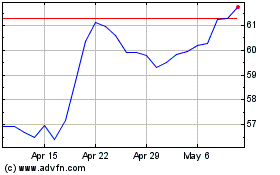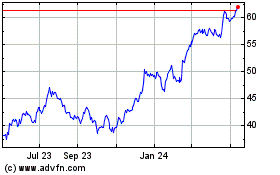By Christopher M. Matthews and Orla McCaffrey
Defenders of the oil-and-gas industry in Washington are fighting
back against big banks who want to stop financing new
Arctic-drilling projects, fearing it could be a harbinger of an
unbankable future for fossil-fuel companies.
Five of the six largest U.S. banks -- Citigroup Inc., Goldman
Sachs Group Inc., JPMorgan Chase & Co., Morgan Stanley and
Wells Fargo & Co. -- have pledged over the past year to end
funding for new drilling and exploration projects in the
Arctic.
Alaska Sen. Dan Sullivan and a group of fellow Republican
lawmakers, mostly from energy-producing states, have been lobbying
the Trump administration to examine whether the federal government
can prevent the banks from cutting off financing, or punish them
for doing so.
Mr. Sullivan said banks are unfairly discriminating against
oil-and-gas producers in Alaska, and that lenders ought to examine
loans on a client-by-client basis instead of denying financing to
an entire category of customers.
"That these banks would discriminate against one of the most
important sectors of the U.S. economy is absurd," Mr. Sullivan said
in an interview. "I thought it was important to push back."
The American Petroleum Institute, one of industry's most
influential lobbying groups, has said it is working with the Trump
administration on the issue, which it called a "bad precedent."
API, Mr. Sullivan and others have also suggested the White House
should examine whether it could cut off the banks' access to
funding under coronavirus relief packages.
Representatives of the banks declined to comment. White House
spokesman Judd Deere said Mr. Trump "has strong concerns if
roadblocks are being thrown up to specifically harm the oil-and-gas
industry."
Wall Street has been pulling back from the oil-and-gas industry
after years of dismal returns from it and is under increasing
pressure from environmentalists and others to limit fossil-fuel
lending. While broader market conditions during the coronavirus
pandemic this year have dried up capital for new exploration, some
analysts have said a lack of bank financing could deter drilling in
the Arctic National Wildlife Refuge, which the administration
opened to exploration in August.
The retreat hastened this year following a collapse in oil
prices because of the new coronavirus and an oil-price war between
Saudi Arabia and Russia. While many expect an oil recovery once the
global economy picks up, the industry is worried about its
long-term access to capital.
In July, the acting head of the Office of the Comptroller of the
Currency, Brian Brooks, said the regulator would examine whether
the banks curtailing lending for new Alaska projects were violating
a federal law the agency says requires banks to provide fair access
to financial services. Mr. Brooks said in a letter to Mr. Sullivan
that the OCC, part of the Treasury Department, would request
information from the banks to explain their decisions.
Bryan Hubbard, an OCC spokesman, said the office is still
gathering information from the banks.
Some believe the OCC might not be able to do much on the matter.
Daniel Stipano, who served as the agency's deputy chief counsel
from 2000 to 2016, said the fair access provision applies to the
OCC itself, not individual lenders. Because financial institutions'
decisions to curtail lending don't necessarily violate the statute,
the OCC is limited in its ability to push banks to provide credit
to certain industries or projects, Mr. Stipano said.
"At the end of the day, the OCC's only ability to compel a bank
to do anything is through enforcement actions, but those have to be
based on legal violations or unsafe and unsound practices," Mr.
Stipano said.
Some environmentalists criticized the politicians' opposition to
the bank policies as legally groundless.
"A growing number of banks are making the obvious business
decision not to finance more drilling in the Arctic because it
would threaten their bottom line and expose them to numerous
risks," said Ben Cushing, who leads the Sierra Club's financial
advocacy campaign. "The idea that this constitutes discrimination
is ludicrous."
Before the recent pledges by banks, lending to the largest
oil-and-gas companies in the Arctic had been growing in the past
few years. Industry financing in the region by 35 leading banks
increased 34% between 2018 and 2019, according to an analysis by
several environmental and financial advocacy groups. The same group
of banks poured $2.7 trillion into fossil-fuel related lending
between late 2015 and 2019.
Still, capital flight remains one of the primary risks facing
the industry, according to Moody's Corp. If the world were to
accelerate a transition to renewable sources of energy, oil-and-gas
reserves could become uneconomic and turn into a credit liability
for producers, making it difficult to access longer-maturity loans,
Moody's said.
Alaska's economy is almost entirely dependent on the fossil-fuel
industry, which has historically funded about 90% of the state's
general fund through tax revenues. Energy executives worry the
pledges that banks are making could spread to other regions and
parts of the industry as pressure mounts from environmental groups,
and companies face the prospect of tighter government regulations.
This week, JPMorgan pledged to push clients to align with the Paris
climate accord and work toward global net zero-emissions by
2050.
"If it is successful, why would they stop with the Arctic?" said
wildcatter Bill Armstrong, founder of Armstrong Oil & Gas Inc.,
which has discovered more than 3 billion barrels of oil in Alaska.
"A lot of misguided people are trying to make oil and gas the new
tobacco."
Write to Christopher M. Matthews at christopher.matthews@wsj.com
and Orla McCaffrey at orla.mccaffrey@wsj.com
(END) Dow Jones Newswires
October 08, 2020 08:05 ET (12:05 GMT)
Copyright (c) 2020 Dow Jones & Company, Inc.
Wells Fargo (NYSE:WFC)
Historical Stock Chart
From Mar 2024 to Apr 2024

Wells Fargo (NYSE:WFC)
Historical Stock Chart
From Apr 2023 to Apr 2024
